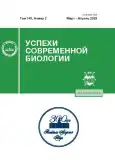Non-Synonymous Single-Nucleotide Mutations and Indels: Contribution to the Molecular Postgenome Portrait of the HepG2 Cell Line
- 作者: Poverennaya E.V.1, Kiseleva O.I.1, Arzumanian V.A.1, Pyatnitskiy M.V.1, Vakhrushev I.V.1, Ponomarenko E.A.1
-
隶属关系:
- Orekhovich Institute of Biomedical Chemistry
- 期: 卷 143, 编号 2 (2023)
- 页面: 107-113
- 栏目: Articles
- ##submission.dateSubmitted##: 17.10.2023
- ##submission.datePublished##: 01.03.2023
- URL: https://journals.rcsi.science/0042-1324/article/view/138931
- DOI: https://doi.org/10.31857/S0042132423020096
- EDN: https://elibrary.ru/KMZWKK
- ID: 138931
如何引用文章
全文:
详细
A comparative analysis of the results of genomic, transcriptomic, and proteomic profiling of HepG2 cell line was carried out in the gene-centric mode. The traceability at the transcriptomic and proteomic levels of changes associated with nonsynonymous single nucleotide substitutions and indels in the genome was shown. Most of the molecular events caused by aberrations at the genomic level are recorded at the transcriptomic level. Only single proteoforms encoded by the selected mutant genes can be reliably detected due to the methodological limitations of proteomic methods, which do not allow the registration of proteoforms present in the sample at low concentrations. The results are consistent with the previously obtained data of other scientific groups and describe the principal methodological solutions required for deciphering the molecular postgenomic portrait of biological samples with a resolution at the level of aberrant molecules.
作者简介
E. Poverennaya
Orekhovich Institute of Biomedical Chemistry
编辑信件的主要联系方式.
Email: k.poverennaya@gmail.com
Russia, Moscow
O. Kiseleva
Orekhovich Institute of Biomedical Chemistry
Email: k.poverennaya@gmail.com
Russia, Moscow
V. Arzumanian
Orekhovich Institute of Biomedical Chemistry
Email: k.poverennaya@gmail.com
Russia, Moscow
M. Pyatnitskiy
Orekhovich Institute of Biomedical Chemistry
Email: k.poverennaya@gmail.com
Russia, Moscow
I. Vakhrushev
Orekhovich Institute of Biomedical Chemistry
Email: k.poverennaya@gmail.com
Russia, Moscow
E. Ponomarenko
Orekhovich Institute of Biomedical Chemistry
Email: k.poverennaya@gmail.com
Russia, Moscow
参考
- Aebersold R., Agar J.N., Amster I.J. et al. How many human proteoforms are there? // Nat. Chem. Biol. 2018. V. 14. № 3. P. 206–214.
- Arzumanian V.A., Kiseleva O.I., Poverennaya E.V. The curious case of the HepG2 cell line: 40 years of expertise // Int. J. Mol. Sci. 2021. V. 22. № 23. P. 13135.
- Edfors F., Danielsson F., Hallström B.B.M. et al. Gene-specific correlation of RNA and protein levels in human cells and tissues // Mol. Syst. Biol. 2016. V. 12. № 10. P. 883.
- GTEx Consortium. Human genomics. The genotype-tissue expression (GTEx) pilot analysis: multitissue gene regulation in humans // Science. 2015. V. 348. № 6235. P. 648–660.
- Kiseleva O., Poverennaya E., Shargunov A., Lisitsa A. Proteomic Cinderella: customized analysis of bulky MS/MS data in one night // J. Bioinform. Comput. Biol. 2018. V. 16. № 1. P. 1740011.
- Liu Y., Mi Y., Mueller T. et al. Multi-omic measurements of heterogeneity in HeLa cells across laboratories // Nat. Biotechnol. 2019. V. 37. № 3. P. 314–322.
- Mellacheruvu D., Wright Z., Couzens A.L. et al. The CRAPome: a contaminant repository for affinity purification – mass spectrometry data // Nat. Methods. 2013. V. 10. № 8. C. 730–736.
- Pyatnitskiy M.A., Arzumanian V.A., Radko S.P. et al. Oxford nanopore minION direct RNA-Seq for systems biology // Biology. 2021. V. 10. № 11. P. 1131.
- Ponomarenko E.A., Poverennaya E.V., Ilgisonis E.V. et al. The size of the human proteome: the width and depth // Int. J. Anal. Chem. 2016. V. 2016. P. 7436849.
- Poverennaya E.V., Ilgisonis E.V., Ponomarenko E.A. et al. Why are the correlations between mRNA and protein levels so low among the 275 predicted protein-coding genes on human chromosome 18? // J. Proteome Res. 2017. V. 16. № 12. P. 4311–4318.
- Poverennaya E., Kiseleva O., Romanova A., Pyatnitskiy M. Predicting functions of uncharacterized human proteins: from canonical to proteoforms // Genes. 2020. V. 11. № 6. P. 677.
- Smith L.M., Kelleher N.L. Proteoform: a single term describing protein complexity // Nat. Methods. 2013. V. 10. № 3. P. 186–187.
- Tenzer S., Leidinger P., Backes C. et al. Integrated quantitative proteomic and transcriptomic analysis of lung tumor and control tissue: a lung cancer showcase // Oncotarget. 2016. V. 7. № 12. P. 14857–14870.
- Trivedi U.H., Cézard T., Bridgett S., Montazam A. et al. Quality control of next-generation sequencing data without a reference // Front. Genet. 2014. V. 5. P. 111.
- van der Auwera G.A., Carneiro M.O., Hartl C. et al. From FastQ data to high confidence variant calls: the genome analysis toolkit best practices pipeline // Curr. Protoc. Bioinformatics. 2013. V. 43. № 1110. P. 11.10.1–11.10.33.
- Vavilov N., Ilgisonis E., Lisitsa A. et al. Number of detected proteins as the function of the sensitivity of proteomic technology in human liver cells // Curr. Protein Pept. Sci. 2022. V. 23. № 4. P. 290–298.
- Venter J.C., Adams M.D., Myers E.W. et al. The sequence of the human genome // Science. 2001. V. 291. № 5507. P. 1304–1351.
- Vitrinel B., Koh H.W.L., Kar F.M. et al. Exploiting interdata relationships in next-generation proteomics analysis // Mol. Cell. Proteomics. 2019. V. 18. № 8. Suppl. 1. P. S5–S14.
- Yip Y.L., Famiglietti M., Gos A. et al. Annotating single amino acid polymorphisms in the UniProt/Swiss-Prot know-ledgebase // Hum. Mutat. 2008. V. 29. № 3. P. 361–366.











